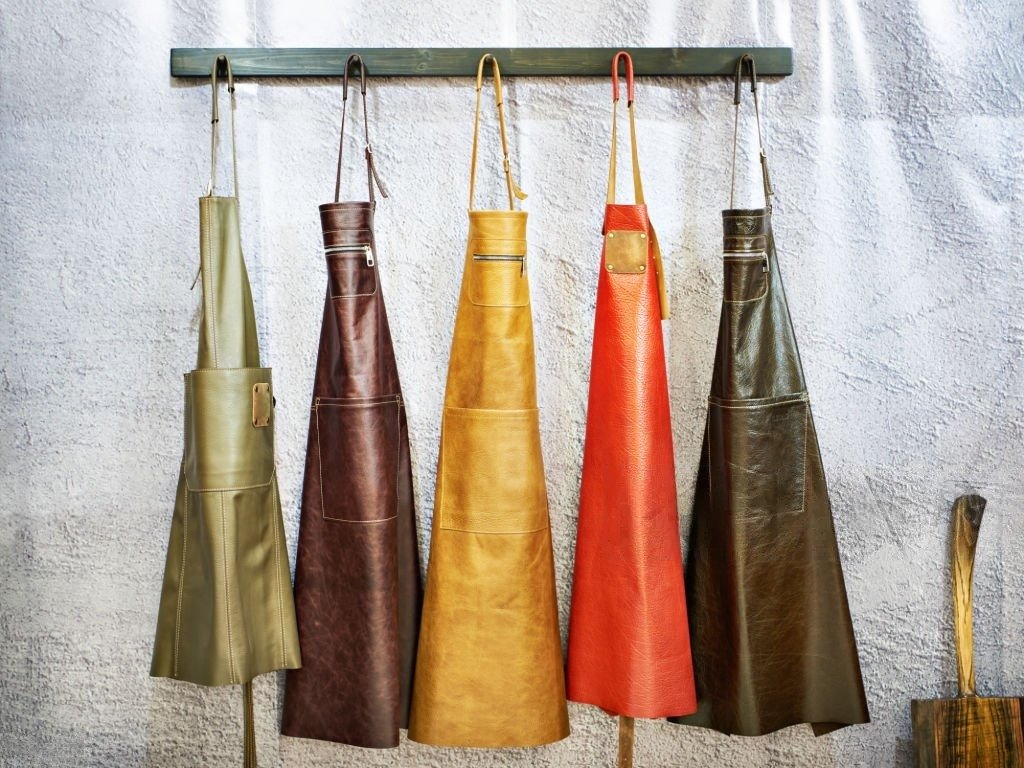No products in the cart.
Leather Apron Buying Guide: Fit, Function, and Features in 2025
Tired of your apron falling apart after just a few uses? Do you feel sore after long hours because of poorly fitting straps or weak material? You’re not alone. Many professionals across kitchens, studios, and workshops face the same frustrations, including uncomfortable fit, lack of proper protection, and aprons that simply don’t last.
This 2025 guide will help you choose the perfect leather apron that blends fit, function, and features. Whether you’re a chef, woodworker, barista, or artist, you’ll find tips to say goodbye to discomfort and hello to durable, stylish, and practical gear that works as hard as you do.
1. Why Choose Leather? The Core Benefits
Look, leather isn’t just about looking cool (though it definitely does). We’ve been using it for centuries for good reason. It genuinely brings something special to the table:
- Tough as Nails: Forget flimsy fabrics. Real leather laughs at everyday scrapes, tears, and wear. It just keeps going.
- Your Shield: Whether it’s rogue sparks in the workshop or a hot pan handle in the kitchen, leather steps up to protect you.
- Timeless Vibe: A leather apron instantly adds a layer of character and pro-level confidence. It never looks out of place.
- Moulds to You: This is the magic. Unlike stiff alternatives, leather softens and shapes itself to your body over time. It gets more comfortable the longer you wear it.
2. Understanding Leather Types
Not all leather works the same. Knowing the types helps you pick one that matches your work style:
- Full-Grain (The Gold Standard): This is top-shelf stuff. It keeps the hide’s natural surface, making it incredibly tough and only looking better with age and use. Think heirloom quality.
- Top-Grain: Smoothed out a bit for a sleeker look, but still seriously durable. You’ll find this in many high-end aprons. Great balance.
- Split Leather: Comes from layers underneath the top surface. Lighter on the wallet (and sometimes the shoulder!), decent for regular use, but won’t have the same ultimate toughness as the top two.
- Suede: Super soft and feels great, but be warned – it loves to soak up stains and isn’t as resilient. Best saved for lighter tasks.
3. Fit and Comfort: Ensuring the Right Size
An apron that fights you all day is the worst. You need it to feel like a second skin so you can just focus on your craft.
- Adjustability is Key: Neck and waist straps must be easy to tweak on the fly to keep everything snug and secure.
- Cross-Back for the Win: These straps are genius. They spread the weight across your shoulders instead of digging into your neck. Your back will thank you later.
- Coverage Choices: Full-length (chest to knees) = max protection. Waist aprons = max movement. Pick your priority!
- Move Freely: You shouldn’t feel restricted. Especially if your job involves lots of bending or reaching, make sure you can move naturally. Honestly, grab a tape measure and try a few styles if you can. It makes all the difference.
Try measuring your body and testing designs to find your best match.
4. Functional Features to Consider
Beyond the basics, keep an eye out for features that make your life easier while you’re working:
- Pockets & Loops (Your Best Friends): Deep, usable pockets and sturdy loops for tools? Essential. You shouldn’t be scrambling for your go-to gear.
- Built Tough for Heat: If hot stuff is part of your world, full-grain leather naturally gives you that crucial buffer against heat. Peace of mind matters.
- Water and Stain Resistance: Treated leather repels liquids, great for kitchens and bars.
- Reinforced Stitching: Strengthened seams at stress points extend apron life.
5. Matching Apron Features to Specific Professions
Different jobs demand different apron features:
- Chefs and Bakers: Need full protection and multiple pockets for utensils. Stain resistance helps.
- Baristas and Bartenders: Prefer stylish, shorter aprons with pockets for tools and cloths.
- Woodworkers and Blacksmiths: Require thick leather and cross-back straps for weight support.
- Artists and Crafters: Opt for lighter aprons with pockets and freedom of movement.
Pick features that help you work smarter and safer.

6. Maintenance and Care Tips
Keep your leather apron in top shape with simple care:
- Cleaning: Wipe dirt off with a damp cloth. Avoid soaking. Use mild soap or leather cleaner if needed.
- Conditioning: Apply conditioner every 3 to 6 months to keep leather soft and prevent cracking.
- Storage: Hang in a cool, dry place. Don’t fold or leave it damp.
Proper care adds years to your apron’s life.
7. Budget Considerations: Finding Value
- Good leather aprons are offered in a range of prices:
Investment pieces are made from full-grain leather with reinforced stitching and are considered perfect for daily use. - Mid-range options are crafted from top-grain leather, balancing quality and cost.
- Budget-friendly aprons are produced using split leather or treated materials and are recommended for occasional use
Pick what fits your budget and needs.
8. Top Leather Apron Recommendations for 2025
Here are some standout picks:
- Premium Pick: ForgePro Full-Grain Heavy-Duty Apron, with cross-back design and multiple pockets, perfect for chefs, blacksmiths, and woodworkers.
- Best Value: CraftMate Top-Grain Utility Apron, affordable, durable, water-resistant, with reinforced stitching.
- Best for Specific Jobs:
- Chef’s Shield Pro, for culinary professionals
- BarBlend Elite, for stylish baristas
- ArtEase Utility Apron, for artists and crafters
9. How to Spot a Quality Leather Apron: Red Flags to Avoid
Avoid wasting money by recognising these warning signs:
- Thin or flimsy leather
- Loose or single stitching
- “Genuine leather”, that’s synthetic
- Rough buckles or sharp hardware
- Strong chemical smells
10. Leather Aprons vs. Fabric Aprons: Which One Wins?
| Feature | Leather Aprons | Fabric Aprons |
| Durability | Long-lasting and tear-resistant | Wears out faster |
| Protection | Excellent against heat and tools | Limited to spills and stains |
| Style | Professional and rugged | Casual and lighter |
| Maintenance | Needs conditioning | Machine washable |
| Cost | Higher upfront cost | Budget-friendly |
Leather wins if durability and protection matter most.
11. Personalization: Customizing Your Leather Apron
Make your apron truly yours:
- Emboss names or logos for branding
- Choose colors from classic browns to blacks or blues
- Customize pocket layout and strap style
Personalized aprons also make thoughtful gifts.
12. Where to Buy: Trusted Leather Apron Brands and Sellers
Shop with confidence at these top sources:
- Etsy: Handmade, customizable options
- Amazon Pro Tools: Wide selection and fast shipping
- Specialty Leather Stores: Brands like Hudson Durable Goods, Texas Canvas Wares, Stalwart Crafts
- Craft and Culinary Shops: Curated for specific professions
Always check reviews and return policies.
Summary
A leather apron is more than just protective gear it supports you through daily challenges. From choosing the right leather type to finding a fit that matches your job, every detail counts. Invest in an apron that feels like a second skin, and you’ll work better, feel confident, and stay protected.
Whether you’re a craftsman, chef, or artist, the right apron becomes a trusted companion. It ages with you, tells a story, and reflects your hard work. Don’t just settle for any apron; choose one that fits your needs and your lifestyle. The right choice can make a big difference in both comfort and performance.
FAQs
Q1: How do I determine the right size for a leather apron?
Measure chest, waist, and apron length. Adjustable straps help fine-tune fit.
Q2: Can leather aprons be used in high-heat environments?
Yes, especially full-grain leather offers excellent heat resistance.
Q3: How often should I condition my leather apron?
Every 3 to 6 months to keep it soft and prevent cracking.
Q4: Are vegan alternatives available?
Yes, waxed canvas and synthetic leather offer durability without animal products.
Q5: Is it worth investing in a high-end leather apron?
Absolutely. High-quality aprons provide better comfort, durability, and protection.










Add comment